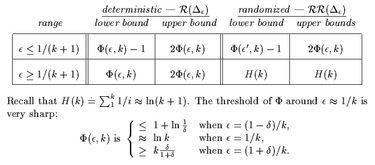neal young / Young00Online
-
Journal of Algorithms 37(1):218-235(2000); SODA'98
 Elias Koutsoupias and Christos Papadimitriou introduced the so-called
diffuse-adversary model for analyzing paging
strategies such as least-recently-used (LRU) [1994]. Briefly,
the diffuse adversary model is as follows. Fix some \(\epsilon >0\)
Run the algorithm, and, for each request, allow the
adversary to assign a probability distribution to the items
such that no item gets probability more than \(\epsilon\), then
request an item randomly from the distribution. (When \(\epsilon\)
is near 1, one has the standard competitive-analysis model;
when \(\epsilon\) is near 0, the adversary is severely
handicapped.) The algorithm is \(c\)-competitive
if the expected cost of the algorithm on the adversarial
sequence is at most \(c\) times the expected cost of the optimal
algorithm.
Elias Koutsoupias and Christos Papadimitriou introduced the so-called
diffuse-adversary model for analyzing paging
strategies such as least-recently-used (LRU) [1994]. Briefly,
the diffuse adversary model is as follows. Fix some \(\epsilon >0\)
Run the algorithm, and, for each request, allow the
adversary to assign a probability distribution to the items
such that no item gets probability more than \(\epsilon\), then
request an item randomly from the distribution. (When \(\epsilon\)
is near 1, one has the standard competitive-analysis model;
when \(\epsilon\) is near 0, the adversary is severely
handicapped.) The algorithm is \(c\)-competitive
if the expected cost of the algorithm on the adversarial
sequence is at most \(c\) times the expected cost of the optimal
algorithm.
Koutsoupias and Papadimitriou proved that LRU was optimally competitive (among deterministic on-line algorithms) according to the model, but left open the question of what the performance guarantee for LRU actually was. This paper answers the question, giving an explicit formula for the performance guarantee within a factor of two. The paper also shows that the performance guarantee of first-in-first-out (FIFO) is much worse than that of LRU, and analyzes the performance guarantees of randomized on-line paging strategies.Journal version of Bounding the diffuse adversary.
© Copyrights are reserved by the publishers.
Download for personal and limited academic use only.